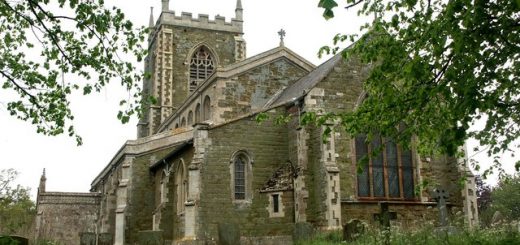The Lady With The Lantern, St Ives
‘The Lady With The Lantern’(1) is a story which appeared in English Fairy and Other Folk Tales’ by Edwin Sidney Hartland [1890]. It is reproduced below complete with footnote.
THE night was dark and the wind high. The heavy waves rolled round the point of “the Island” into St. Ives Bay, as Atlantic waves only can roll. Everything bespoke a storm of no ordinary character. There were no ships in the bay–not a fishing-boat was afloat. The few small trading vessels had run into Hayle for shelter, or had nestled themselves within that very unquiet resting-place, St. Ives pier. The fishing-boats were all high and dry on the sands.
Moving over the rocks which run out into the sea from the eastern side of “the Island” was seen a light. It passed over the most rugged ridges, formed by the intrusive Greenstone masses, and over the sharp edges of the upturned slate-rocks, with apparent ease. Forth and back–to and from–wandered the light.
“Ha!” said an old sailor with a sigh, as he looked out over the sea; “a sad night! a sad night! The Lady and the Lantern is out.”
“The Lady and the Lantern,” repeated I; “what do you mean?”
“The light out yonder–“
“Is from the lantern of some fisherman looking for something he has lost,” interrupted I.
“Never a fisherman nor a ‘salt’ either would venture there to-night,” said the sailor.
“What is it, then?” I curiously inquired.
“Ha’ast never heard of the Lady and the Lantern?” asked a woman who was standing by.
“Never.”
Without any preface, she began at once to enlighten me. I am compelled, however, to reduce her rambling story to something like order, and to make her long-drawn tale as concise as possible.
In the year–there were many wrecks around the coast. It was a melancholy time. For more than a month there had been a succession of storms, each one more severe than the preceding one. At length, one evening, just about dusk, a large ship came suddenly out of the mist. Her position, it was at once discovered, equally by those on board and by the people on the shore, was perilous beyond hope. The sailors, as soon as they saw how near they were to the shore, made every effort to save the ship, and then to prepare for saving themselves. The tempest raged with such fury from the west that the ship parted her anchors at the moment her strain came upon them, and she swung round–her only sail flying into ribbons in the gale–rushing, as it were, eagerly upon her fate. Presently she struck violently upon a sunken rock, and her masts went by the board, the waves sweeping over her, and clearing her decks. Many perished at once, and, as each successive wave urged her onward, others of the hardy and daring seamen were swept into the angry sea.
Notwithstanding the severity of the storm, a boat was manned by the St. Ives fishermen, and launched from within the pier. Their perfect knowledge of their work enabled them, by the efforts of willing hearts, anxiously desiring to succour the distressed, to round the pier-head, and to row towards the ship.
These fishermen brought their boat near to the ship. It was impossible to get close to her, and they called to the sailors on board to throw them ropes. This they were enabled to do, and some two or three of the sailors lowered themselves by their aid, and were hauled into the boat.
Then a group appeared on the deck, surrounding and supporting a lady, who held a child in her arms. They were imploring her to give her charge into the strong arms of a man ere they endeavoured to pass her from the ship to the boat.
The lady could not be prevailed on to part with the infant. The ship was fast breaking up, not a moment could be lost. So the lady, holding her child, was lowered into the sea, and eagerly the fishermen drew her through the waves towards the boat.
In her passage the lady had fainted, and she was taken into the boat without the infant. The child had fallen from her arms, and was lost in the boiling waters.
Many of the crew were saved by these adventurous men, and taken safely into St. Ives. Before morning the shore was strewed with fragments of wreck, and the mighty ship had disappeared.
Life returned to the lady; but, finding that her child was gone, it returned without hope, and she speedily closed her eyes in death. In the churchyard they buried her; but, shortly after her burial, a lady was seen to pass over the wall of the churchyard, on to the beach, and walk towards the Island. There she spent hours amidst the rocks, looking for her child, and, not finding it, she would sigh deeply and return to her grave. When the nights were tempestuous or very dark, she carried a lantern; but on fine nights she made her search without a light. The Lady and the Lantern have ever been regarded as predictors of disaster on this shore.
Footnotes
(1) Robert Hunt, Popular Romances of the West of England, 2nd series, p. 143.




Recent Comments